[Click on BLUE text to link to more information]
“We’re poets and we drink coffee!”
(attributed to Roberto Bolaño in The Savage Detectives)
The word “coffee” appears 71 times in the The Savage Detectives by Roberto Bolaño. It’s reasonable to think that Bolaño actually wrote the line “We’re poets and we drink coffee.” But, he didn’t. It was suggested as something he might write by Benjamin Obler. I didn’t have to tell you that. You might have been more amused if I left you in the dark. But, I couldn’t do that. I wouldn’t do that. Still, 71 times is a lot. It’s certainly reasonable to assume coffee was important to Bolaño. Coffee was the inspiration for many writers as well as artists, tradesmen, teachers, and loafers. That I will try to show below.
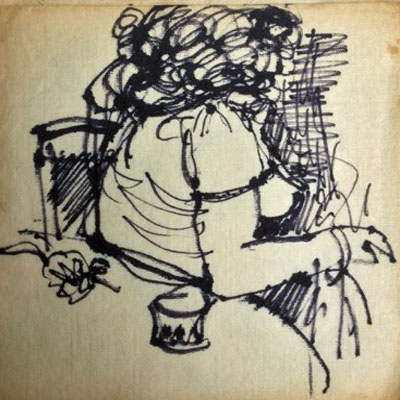
Sea Gull Cellar Bar Napkin Art, artist unknown
Coffee has played an important role in literature, the arts, and politics from the beginning. According to Sean Paajanen, “the first record of a public place serving coffee dates back to 1475. Kiva Han was apparently the name of the first coffee shop, located in the Turkish city of Constantinople (now Istanbul) … Coffee was such an important item during that time period that it was legal in Turkey for a woman to divorce her husband if he could not supply her with enough coffee.”
“It was in an English coffee house that the word “tips” was first used for gratuities. A jar with a sign reading, “To Insure Prompt Service” sat on the counter. You put a coin in the jar to be served quickly.” (Paajanen)
For five centuries coffee was mostly just coffee. Then came espresso. In 1946, (the year I was born) Gaggia invented the commercial piston espresso machine, easier to use and safer than earlier models. Soon we were off to the races.
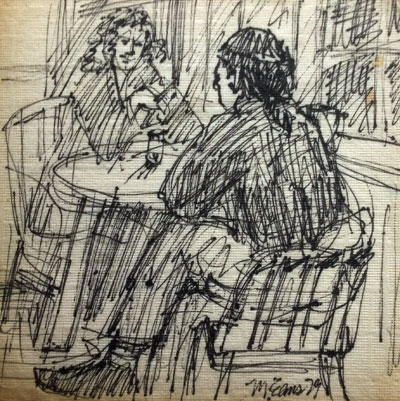
Sea Gull Cellar Bar Napkin Art, Mike Evans artist
With the emergence of laptops, iPhones and iPADS coffee went boutique. Gourmet coffees and espresso drinks arrived—iced coffees, lattes, cappuccinos, macchiato, caramel frappuccinos, the flat white, an endless variety of flavored hot drinks. The coffee world of today is a far cry from those early days yet the goings on in coffee houses are essentially the same as they’ve always been.
The Sea Gull Coffee Shop was once a thriving and popular hangout in Mendocino. As the owner, I was witness to multiple idiosyncrasies of coffee drinkers. I am a coffee addict. That’s what owning the coffee shop did to me.
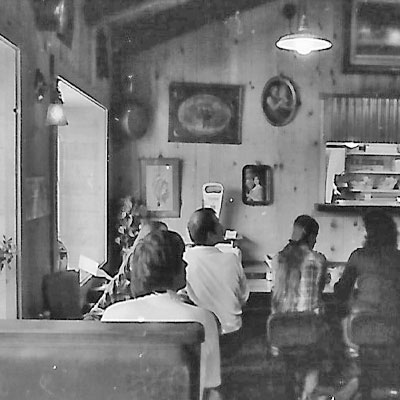
Sea Gull Coffee Shop, Nicholas Wilson photographer
On any given morning Don, Skip, Ken and sometimes Jack would be the first to arrive. Locals. Contractor, electrician, school bus driver, fisherman. They settled at a round table in the middle of the room between the two counters and ten stools and the smaller tables by the windows. They were the unofficial traffic cops, the keepers of order in a room where an eclectic mix of locals and tourists gathered to discuss business and politics or simply listen, to enjoy coffee and sometimes breakfast. An animated banter took place between the patrons in the coffee shop. Sometimes the cooks joined in through a window in the wall open to the kitchen.
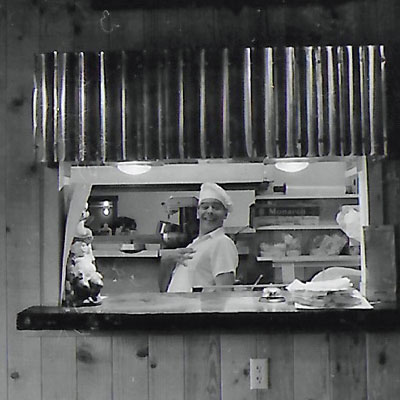
David Gottsche, chef, photograph Nicholas Wilson
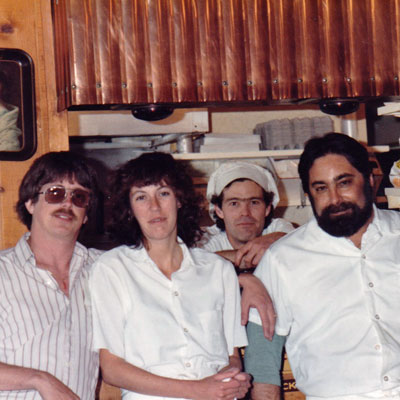
David, Angie, David, Gary
My young son grew up with these discussions. He would learn the lingo and carry on conversations with himself when he played with his toy trucks and cars. Alone at home, he sometimes took on the personality of one or another of the regulars.
He’d mimic the husky, deep voice of Big Al. Al was an imposing sight—tall, black, hair in Rastafarian style—but gentle as a lamb. He could annoy the waitresses at times. He sat at the counter. He was not forthcoming with his order.
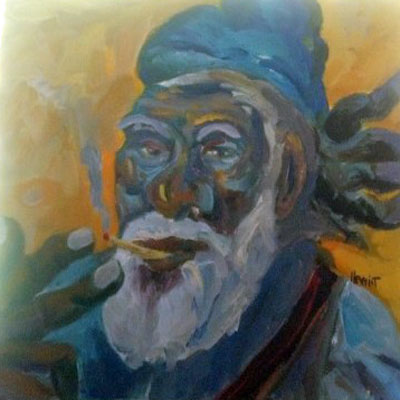
Painting of Big Al by his daughter Lisa
“What do you want today, Al?”
“Bread.”
The waitress brought the bread in a basket with butter and set him up with a paper napkin and silverware.
“Soup.”
She went to get the soup.
“Salad.”
At this point the waitress, who ruled the coffee shop by sheer force of personality, would put her hand on her hip and gave Big Al a cross-eyed look.
“Al, I’ve told you, order everything at once. Just say ‘bread, soup, salad’ in one sentence. Is that so hard?”
Long pause.
“Roquefort.”
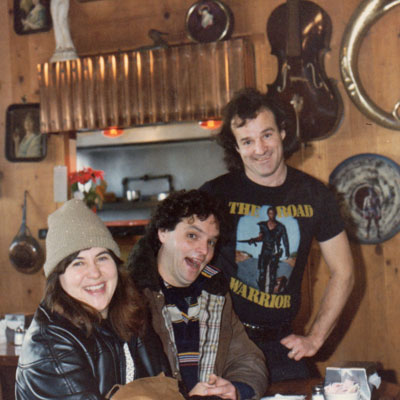
Jeannie, Doug, Sheldon
Should I kill myself or have a cup of coffee? Camus, A Happy Death
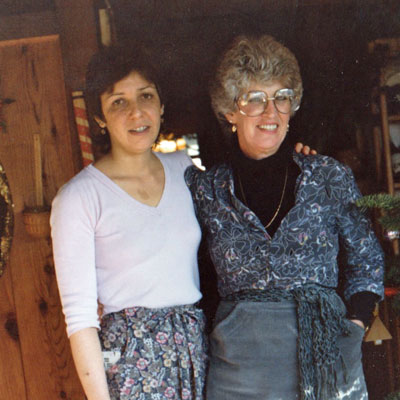
Linda and Marlene
Bessie Strauss was another (sort of) regular. Short, of ancient vintage, living alone, she wore the same faded grandma print every time I saw her. She arrived each month to “pay her water bill.” She got no further than the register, never pierced the inner sanctum. There was no time for coffee or pie or anything else. Bessie owned the building adjacent to the Sea Gull Inn. (Now the Headlands Inn) There was a water line underground from the well on the Sea Gull property to her house. How and when that line was installed, no one knew. She lived in just two rooms. The other rooms were packed full with the detritus of years past. By some long undefined tradition she bought her water from the Sea Gull for $3 – $4 a month, a price she set on her own based on her usage. I still have one receipt that cashier/hostess Lorna Young made for June 1974.
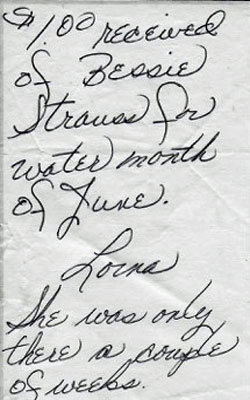
One of Bessie’s many quirks was to emerge early in the morning from her front door to walk across the alleyway between the two properties. She looked carefully to see that she was in the clear. Then, quickly to avoid detection, she threw a bag onto the Sea Gull property. That was how she disposed of her garbage. We retrieved the bag and deposited it into our trash when she was gone. No one ever mentioned this. It was just the way it was.
I have measured out my life with coffee spoons. T. S. Eliot, The Love Song of J. Alfred Prufrock
Artists and musicians, authors and poets along with the local tradesmen were among the regulars. Some were celebrities, some were not. A few names—Kent Chapman, Leonard Cohen, Arlo Guthrie, Richard Brautigan, Truman Capote, Chester Anderson, Bill Zacha, Bob Avery, James Maxwell, Charles Stevenson, and Martin Schmidt, Larry Fuente—I know for specific reasons. Others I’ve forgotten. Bobby Markels, ruth weiss, Bill Bradd and Gordon Black and Mitchell Zucker and Ilja Tinfo (the last four were also employees), Sharon Doubiago, Jay Frankston, Colonel Wingnuts, Luke Breit, and more. For a larger list of characters, skip to the bottom where I’ve chronicled a number of regulars with the help of the local newspaper.
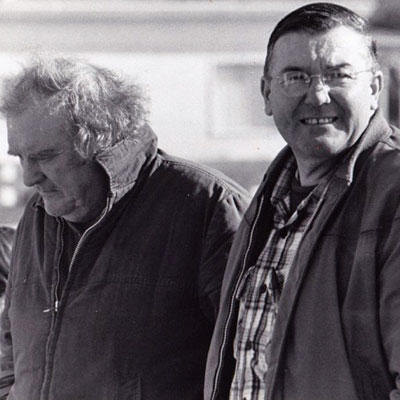
Coffee shop regulars Byrd Baker and Jacques Helfer, Nicholas Wilson photographer
In several previous blogs I have related some of my memories of the Sea Gull Coffee Shop. Here are some of the links.
Clifford
Coffee
B-Not
How Richard Brautigan Saved My Life
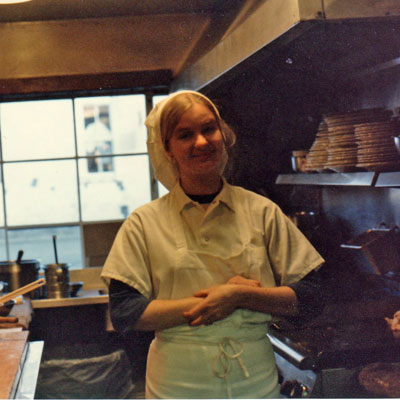
Vicki
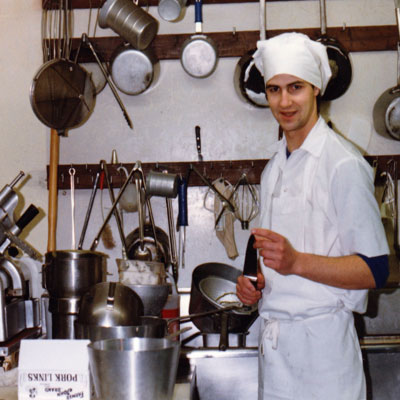
John Bush
Coffee is about camaraderie. Some say its good for the soul like soup. All I know is that I can’t live without it and from years of experience in the restaurant my sense is that I am not alone.
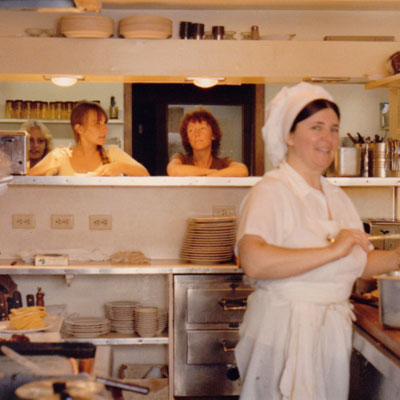
Left to Right: Lynn, Debbie, Daphne, Sharon
Gerald “Fud” Ford: “The beatnik days were happening then. Jim used to like— instead of listening to rock & roll records— he’d read Kenneth Rexroth and stuff like that. We’d go over to the coffeehouses and hang out in front and, you know, wearing sweatshirts and Levi’s.
We’d go over and hang out. Put on sweatshirts and Levi’s and wear sandals and go over and hang about in front of the coffeehouses and go in and listen to the poetry sometimes; try and steal wine, spend time out at Playland-at-the-Beach. That was a great place to have fun for a kid; gone now. [Playland was a ten-acre seaside amusement park next to Ocean Beach on the west side of San Francisco that closed in 1972.]
Frank Lisciandro: Jim Morrison: Friends Gathered Together
Local woodworker, Philip O’Leno, who built the bar for the new Sea Gull after the fire close friends with Jim Morrison back in their college days as documented in Lisciandro’s book. I had some amazing discussions with Phillip while he was installing the bar and other wooden creations he crafted for Cellar Bar. (We didn’t change the name even though we moved the bar upstairs. I used the excuse that the Catholic priest had printed it on his business cards before the fire.) Phillip knew about Ginsberg and Blake. A woodworker that knew his poets defines the Mendocino at that time.
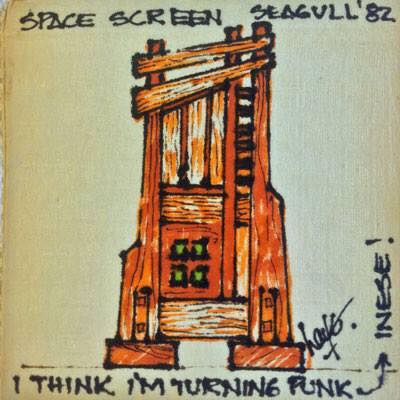
Sea Gull Cellar Bar Napkin Art, Jack Haye artist
Bearded robots drink from Uranium coffee cups on Saturn’s ring.
Allen Ginsberg: Collected Poems 1947-1997
Some say coffee acts like a truth serum, that it can remove the veil of self-delusion. I’ve found that to be true. Never have I been so thoroughly in touch with my failings as after I’ve had a few cups of coffee and gazed into the mirror. Coffee can make you perky and coffee has its perks. You might think I’m over-hyping the benefits. If that’s what you think, you’ve obviously never drank a cup of real coffee. Gordon Black, janitor/poet/radio-personality, exemplifies the power of a good cup of coffee in the picture below. He is wearing a T-shirt designed by himself that subsequently led to a series of Sea Gull T-shirts. James Maxwell used the photograph in depicting Gordon in one of the Sea Gull Paintings (Row, row, row). [Thanks to Gordon for setting me straight on this in his comment below]
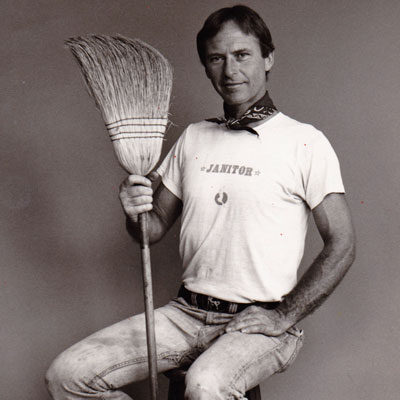
Gordon, Eliza Hicks photographer
I just want a hot cup of coffee, black, and I don’t want to hear about your troubles. Charles Bukowski
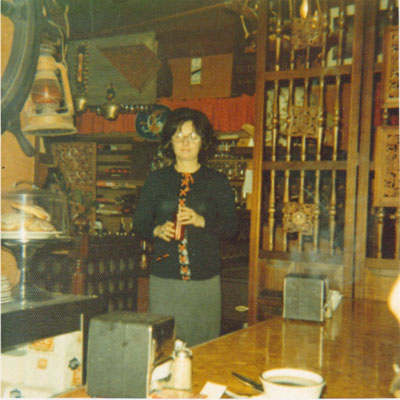
Marlene Hall in the original Sea Gull Coffee Shop
Coffee can change the scene, set the mood, even control the mind. Listen to David Byrne of Talking Heads explain the coffee chains in Venezuela.
In Venezuela there are chains of coffee shops where the clientele, almost exclusively male, is waited on by attractive women in tight outfits. The twist—what separates this chain from ordinary coffee shops—is that the interior architecture allows the female waitstaff to tower over the men. The women are positioned behind the counter on a slightly elevated platform. This means the typical Latin macho man is either being put in his place, and enjoying it, or that he is being transported back to his childhood, where his primary view is of his mother’s breasts looming conveniently above him. David Byrne: Bicycle Diaries
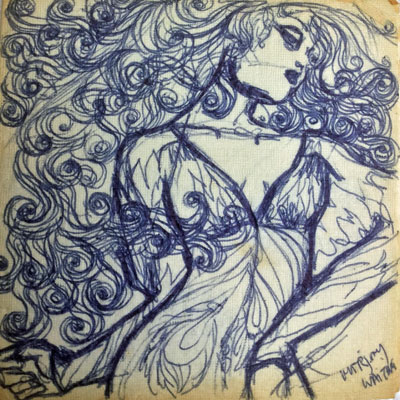
Sea Gull Cellar Bar Napkin Art, Marjorie Whittig artist
The coffee shop is where people exchange ideas, watch, listen and conduct business. There are those who feel more productive in a coffee shop, who actually work there. Others go just to hang out and relax, to read, or to meet friends. Gene Clark, founding member of The Byrds, is one of many famous people who sometimes hung out at the Sea Gull.
Gene expounded to Domenic Priore in 1985,”People sometimes think, and I know they’ve asked this of Dylan,’Do you write songs out of personal experiences or do you write songs like a novelist writes a novel?’ Actually, in many cases you write them out of examples you get from watching other people or situations you see, or just dream up a situation. It is sort of like a novel writer. It’s not always written because you went through a particular situation. A lot of times they are, but for the most part, most of the songs I’ve written are from observations. Something you see. Like you could be sitting at a coffee shop and see some guy arguing with his old lady or something and write a song about it.” John Einarson: Gene Clark. Mr. Tambourine Man: The Life and Legacy of The Byrds’
Coffee can help you set your goals, take the initiative, move forward. You want to convince some guy to ask you on a date? Even ask you to marry him? Offer him a cup of coffee. Some claim coffee is an antidote for madness, a way to reconnect with your own synapses, to reset the senses, to firm up your sense of reality. The “coffee eyes” below confirm this.
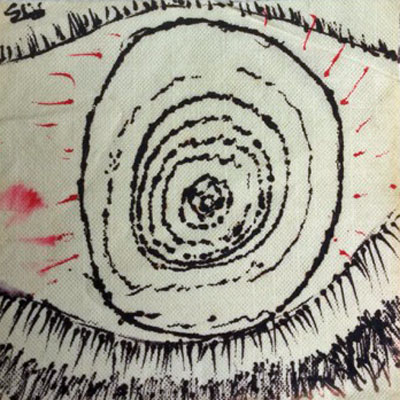
Sea Gull Cellar Bar Napkin Art, R.T.S. artist
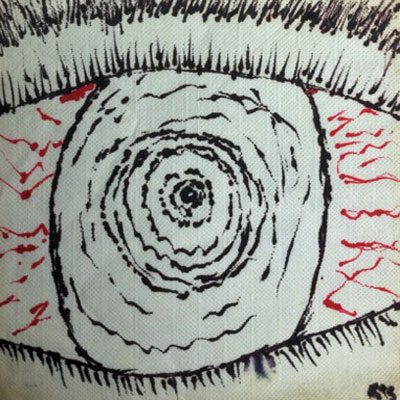
Sea Gull Cellar Bar Napkin Art, R.T.S. artist
To clear the record, I want to say that not only did we allow women in the Sea Gull Coffee Shop, we encouraged them and they were equal in all ways if not superior to the men. Ina from Mendosas brought her own tuna fish in a can to sprinkle on her “plain green salad.” Peggy with her unruly son Dillon sat by the front door, It was a major vacuum job under the table after Dillon and his mother left. Char spent hours drawing pictures of horses. There were many, many famous women going in and out of the coffee shop in those days.

Sea Gull Cellar Bar Napkin Art, artist unknown
The history of coffee is like history in general. It is filled with both the positive and the negative. Uruguayan writer Eduardo Galeano points this out in a single paragraph from his book Mirrors.
Death to Tea, Long Live Coffee
The British Crown decreed that its colonies had to pay an unpayable tax. In 1773, furious colonists in North America sent forty tons of London tea to the bottom of the harbor. The operation was dubbed the Boston Tea Party. And the American Revolution began. Coffee became a symbol of patriotism, though there was nothing patriotic about it. It had been discovered who knows when in the hinterland of Ethiopia, when goats ate the red fruit of a bush and danced all night, and after a voyage of centuries it reached the Caribbean. In 1776, Boston’s cafés were dens of conspiracy against the British Crown. And years later, President George Washington held court in a café that sold slaves and coffee cultivated by slaves in the Caribbean. A century later, the men who won the West drank coffee by the light of their campfires, not tea. Eduardo Galleano: Mirrors: Stories of Almost Everyone

Marlene cooking in the old kitchen
Historically theologians and scholars would gather at one coffee house, stock brokers at another and sea-faring merchants at another. Not only poets but physicists also have found inspiration in coffee. We had them all in one room at the Sea Gull.
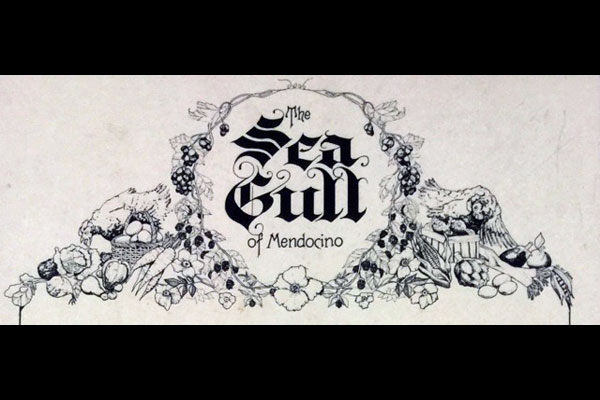
Menu design for new Sea Gull, Judy Brown artist
The scene is a coffeehouse. The Café Josephinum is a smell first, a stinging smell of roasted Turkish beans too heavy to waft on air and so waiting instead for the more powerful current of steam blown off the surface of boiling saucers fomenting to coffee. By merely snorting the vapors out of the air, patrons become overstimulated. The café appears in the brain as this delicious, muddy scent first, awaking a memory of the shifting room of mirrors second— the memory nearly as energetic as the actual sight of the room, which appears in the mind only third. The coffee is a fuel to power ideas. Janna Levin: A Madman Dreams of Turing Machines
Sometimes its only a cup of coffee that gets you through the day. Shirley Jackson, famous for her story The Lottery, wrote about the therapeutic benefits of coffee in her amusing book about motherhood, Life Among the Savages.
“And how do you feel? Well?” “I surely do,” I said. I took my c offee into the dining room and settled down with the morning paper. A woman in New York had had twins in a taxi. A woman in Ohio had just had her seventeenth child. A twelve-year-old girl in Mexico had given birth to a thirteen-pound boy. The lead article on the woman’s page was about how to adjust the older child to the new baby. I finally found an account of an axe murder on page seventeen, and held my coffee cup up to my face to see if the steam might revive me. Shirley Jackson: Life among the Savages
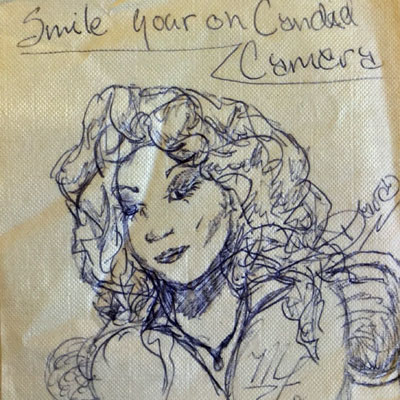
Sea Gull Cellar Bar Napkin Art, artist unknown
Coffee keeps you going when you’re struggling to keep awake. Sometimes it’s the only thing that can. This is especially true for students. Kafka knew this and used it in his book on Amerika. I’ve always found interesting that Kafka wrote a book about America even though it was a place he’d only visited in his imagination. Coffee?
“Oh, as for sleeping!” said the student, “I shall sleep once I’m finished with my studies. As for now, I just drink black coffee.” And he turned around, pulled a large flask from under his desk, poured black coffee into a little cup, and downed it, the way one swallows medicines quickly so as to avoid noticing the taste. “It’s such a great thing, black coffee,” said the student, “it’s a pity you’re so far away and I can’t hand you some.” “I don’t like black coffee,” said Karl. “Nor do I,” said the student, laughing. “But where would I be without it. If it weren’t for black coffee, Montly wouldn’t keep me a moment longer. I always say Montly, but of course he doesn’t even have the slightest notion I exist. I really have no idea how I would keep going at work if I didn’t always keep a flask this big in my desk, for I’ve never yet dared to give up drinking coffee, but believe me, it wouldn’t be long before I’d be lying behind the desk fast asleep. Unfortunately, people can sense this, at work they call me Black Coffee; it’s a stupid joke that has certainly harmed my chances of getting ahead.” Franz Kafka, Amerika or The Missing Person
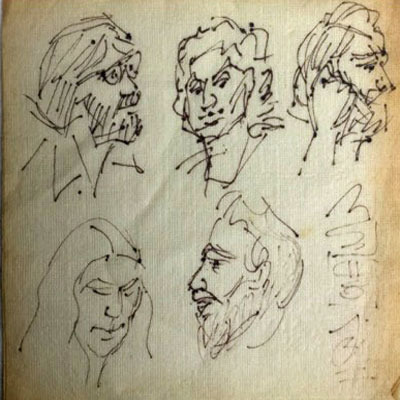
Sea Gull Cellar Bar Napkin Art, artist unknown
Coffee has been written into so many poems, stories, and novels that its impossible to keep track. Richard Brautigan, who visited the Sea Gull, included a story titled simply “Coffee” in Revenge of the Lawn, a book of his short fiction.
They say in the spring a young man’s fancy turns to thoughts of love. Perhaps if he has enough time left over, his fancy can even make room for a cup of coffee. Richard Brautigan, Revenge of the Lawn, The Abortion, So the Wind Won’t Blow It All Away
Coffee is so essential to writers that an entire publishing company has been named after coffee.
Coffee House Press THE MISSION of Coffee House Press is to publish exciting, vital, and enduring authors of our time; to delight and inspire readers; to contribute to the cultural life of our community; and to enrich our literary heritage. By building on the best traditions of publishing and the book arts, we produce books that celebrate imagination, innovation in the craft of writing, and the many authentic voices of the American experience. Visit us at coffeehousepress.org.
Coffee House Press publishes one of my favorite new authors, Valeria Luiselli. She herself is a lover of fine coffee. She wrote a paragraph on coffee’s ability to help pass the time.
I’d been in the Lebanese café for a few hours waiting for the rain to pass, half reading a scholarly edition of Rousseau’s Meditations, half studying a group of old men drinking coffee and silently playing dominos at the next table. I’d got stuck on a Rousseauian phrase, possibly more ingenious than rational, about how adversity is a schoolmistress whose teaching comes too late to be truly useful. Salvatore remembered that meditation, he said. I had a Pentax with me that I’d just picked up from one of the camera repair shops on the street and, more from boredom than real interest, I’d been taking photos of the old men. Slow-witted pupils of adversity, Salvatore concluded, thinking himself very clever. When it finally stopped raining, I took a last gulp of coffee, put a twenty-peso bill under the sugar bowl, and made my way to the door. (Passing the old men’s table, I overheard them speculating about the firmness of my ass.) I stopped in the doorway for a moment to look along the street: rain-soaked, Mexico City returns to being that valley that obsessed Cortés, Juan Zorrilla, and Velasco. I raised the camera, focused on a Rousseauian pedestrian who, at that moment, was jumping over a puddle, and shot. Valeria Luiselli: Faces in the Crowd
Is it possible to measure the quality of your life with cups of coffee? Will coffee help you get in touch with your emotions? Can coffee assist you in deciphering the mystery of life? Yes, yes and yes again. In conclusion, I will return to Roberto Bolaño’s The Savage Detectives.
“And I asked the boys, I said, boys, what do you make of this poem? I said, boys, I’ve been looking at it for more than forty years and I’ve never understood a goddamn thing…I remember that while I was drinking the coffee the boys sat down across from me again and talked about the other pieces in Caborca. Well, then, I said, what’s the mystery? Then the boys looked at me and said: there is no mystery Amadeo.”

THE NAMES: SEA GULL BUILDERS, CHARACTERS, EMPLOYEES, FRIENDS, AND PASSERS THROUGH – THANKS TO ALL FOR WHAT YOU DID FOR US
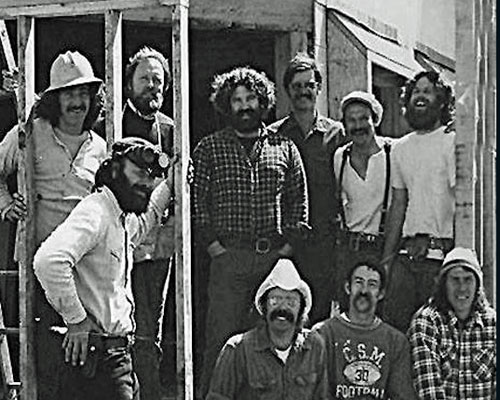
Some of the Crew, Nicholas Wilson photographer
The Crew That Rebuild the Sea Gull (Mendocino Beacon, June 16, 1977)
Mike Nielson
Gus Acosta
Phil Brock
Chris Brown
Steve Scudder
Neil Erikson
Dick Barham
Dan Wilson
Rick Lane
Cheryl McConnell
Sally Howell
Tom Quinn
Kathy O’Grady
Judy Brown
Nehemiah Bear
Bruce Dahl
Lloyd Taylor
John Fredericks
Ilja Tinfo
Steve Weingarten
Len Peterson
Paul Townsend
Pat LaDue
Stuart Marks
Elmer Whaley
Ralph Umbertis
Suzy Wilson
Bill Spencer
Patti Larrick
John Knobber
Brian Lee
Phillip Oleno
Leone McNiel
Jim Schell
James Rolfe
James Maxwell
Stan Kelly
Ken Stevens
Lucy Loren
Bob Zvolensky
Beverly Francis-Gunsul
Gail Lucas
John Birchard
John Chamberlain
Byrd Baker
Bruce Sloan
Eleanor Hill Edwards
Lew Harris
Tom Griffiths
Bill Provost
Sam McNeil
Harriet and Dr. Tepfer
Jack Moyer
Dick Mabbatt
Clifford Doolittle
Cherie Christiansen
Lorna Young
David Clayton
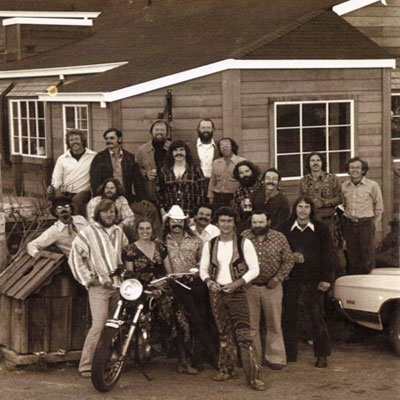
Another Crew Picture, Nicholas Wilson photographer
Sea Gull Customers, Friends, Employees and Passers Through (Mendocino Beacon, August 29, 1985)
Marlene McIntyre
Julia Calouro
Angie Panfilio
David Russell
Steve Budnick
Randy, Paula, Shannon and Aaron Panfilio
Janet Morris
Kathy Kiefer
Carl Stevens
Linda Stroh
Sula Combs
Beck Dodds
Richard Albright
Dr. David & Cathy Baines (Cathy Panfilio)
Kelly Sanger
Allison Browne
Roseanne Sink
Berverlee, Don & John Younger
Monty & Barbara Reed
Joan & Jack Carlson
Don Pollard
Biage Quattrocchi
Dick & Laura Brandon
Jeff, Bobby and Sis Burdick
Rod Holden
Geo Masterson
Jeanne Sullivan
Barbara Grable
Walter Mapes
Ed Glazer
Bill & Gwen Jacobson
Bob Heron
Linda Friedman
Michael Nankervis
Richard Cooper
Ruth & Peter Veres
Carolyn & Mike Kostick
Brenda & Larry Costa
Patsy Brown
Ray Furey
Francis Rutherford
Peter Cecchi
Jason Keseric
Skip Jones
Kenneth Shrode
Hank Dahl
Bob Rosenfeld
James Maxwell
Fred Greer
Bob & Jean Droz
Charlie Remer
Ellen Callas
Greg Hillman
Shawnis Michaels
Doug Nunn
Tracy Burns
Hit & Run Theatre
Richard Reeves
Sheila Burns Sosnovec
Antonia Lamb
Jim Lamb
Baby Fae and the Heart Throbs
Carlotta
Georgia Lane
Vicki Ward
Carl Hayward
Marina Balassi
Kathie Golightly
Kita Alford
Al Fiefer
Gary Aumack
Craig Tingle
Pacini Wines
Butch Deas
Michael Beck
Sheila Kirbow
John Rogers
The Story Book Playes
John Fredricks
Neva Beach
Jo McClure
Lee Welty
Harry Rothman
Gordon Black
David & Marie Matlin
Dee & Rich Lemos
Rick Lemos
Bruce Dahl
Bonnie Tillotson
Laura Grube
Ilja Tinfo
John Bush
Mark Perkins
Chris Lloyd
Marie Ripley
Karin Givon
Grace Sandefur
Kristy Hotchkiss
Bob & Carol Goodwin Blick
Blayne Link
Oscar
The Scudders
Tom Quinn
Jackie Dornan
Bev & Jake Van Horn
Charley Swehla
Bill Vargas
Steve LaChapelle
Emery Burkey
Thom Thompson
John Wetzler
Deb Kelly
Martha Wagner
Bill Wagner
Mike L. Evans
Wolfgang Hasselkuss
Linda Stuart
Pam Rose
Mr. & Mrs. August Brings
Mamie Mendosa
Alvin & Jeanette Mendosa
Mary Kuvaja
Susie Zipp
Mary Dougherty
Lee & Lorena Edmundson
Jack Kronfeld
Eric Schmid
Patti Long
Joan & Jeff Stanford
Betty Chastain
Bob & Dorothy Ayres
Mark Hughes
Marc Diamond
Karl Schoen
Daney Dawson
The Bob Ayres Big Band
Carla Jupiter
Nancy New
Toni Dance
Lorna Young
Bob & Verna Defer
Chris Hayter
Eva Anderson
Judy Sperling
Ruth Dobberpuhl
Richard Yaski
Leila Bryant
Josh Maloney
Daphne Jacobson
Roy Hoggard
Gary Sheppard
Frank Meyers
Fred Lemin
Eric Jordan
Bill McNeil
Carolyn Lundquist
Fancy That
Tickle Your Fancy
David Gross
Mitch Ortiz
Mendocino Bakery
Laoma Bryant
Estelle Grunewald
Michael Grean
Napkin Artists
Sandra Lindstrom
Deb Fedornak
Charlene Stevens
Larry & Lorraine Halter
Joanie James
Myrna Sharp
Kevin & JoAnn Athey
Mark Engleman
Bessy Moore
Monique Timberlake
Mendocino Coast Jazz Society
Sharon Schlesenger
John Chamberlain
- Rudin
Peter & Diane Wells
Gary Olander
Frederick Geers
Nita & Ed Pillsbury
Matt & Ute Roland
Denali & Tom Files
Jack Fremont
Rhoda Teplow
Arlene Crandall
Rosana Rathbun
Harold Robinson
Sunny, Danny & Leif Barca
Mendocino Music
Gloriana Opera Co.
Sally Stevens
Mike Westerlund
George Spiker Manchester
Tom Brist
Rosie O’Grady
Grail Dawson
Betty Barber
Elinor Hayes
Dwain Ray
Bill Zacha
Jennie Zacha
Maydene Burtt
Dottie Hill
Sheldon Cox
Barbara Lane
Betty & Warren Williams
Michael Jolliffe
Jean Sidjakov
Bobby Markels
Gale & Marva Brandon
Lee Larson
Eve Rice
Gail Lauinger
Jenny Otter
Kathi Griffen
Mrs. T
Randy King
Fran & Larry Heit
Rainsong
Melting Pot
Old Gold
Alice Wittig
Marilee Acklin
Katherine & Harold Henderson
Déjà vu
Mike Velasquez
Mark Safron
Jim & Judy Tarbell
Sue Siskin
Don & Shirley Kirkpatrick
North Coast Cookie Co.
Peter Lit
Joanna C. H. Lamb
Mendocino Beacon
Colonel Wingnuts
Great Put On
Elan
Metro
Penny & John d’Arcy
Jim & Rochelle Marquardt
Betty J. Allen & Cory Wisnia
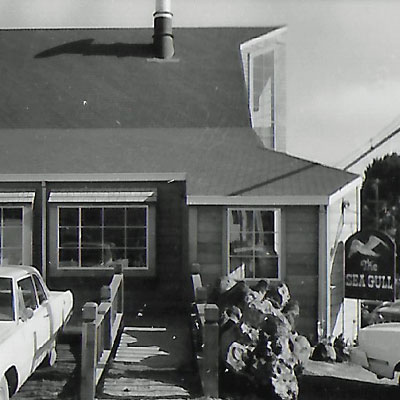
Entrance to the Sea Gull Coffee Shop, Nicholas Wilson photographer

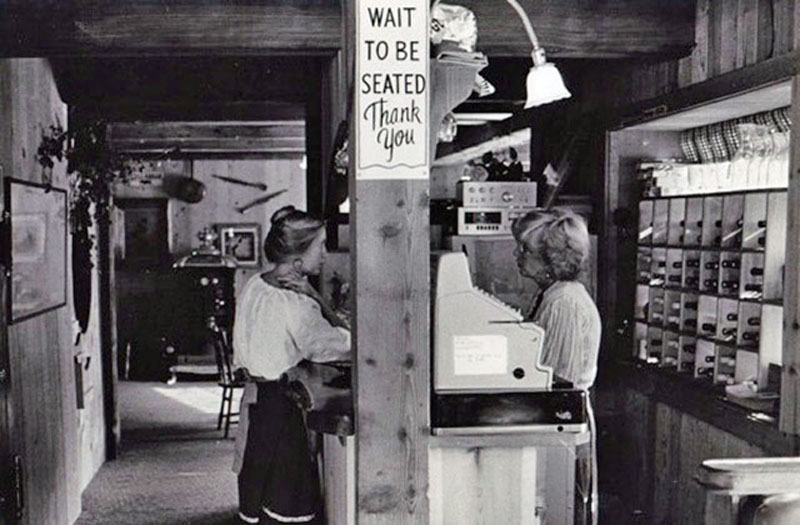
I love that Menu Design artwork…beautiful! AND…mention of Playland at the Beach brought those memories rushing home. Many days spent over there when I was a youngster! Thank you!
What a time, what a place! We were in heaven. All things were possible. Thanks, David, for employing everybody! The Sea Gull was the town living room; if you wanted to see somebody, you’d go to the Gull and wait. It’s music to eye the long list of names, each a sweet (or sometimes integrally sour) note. Btw the masterful b/w print of me was not done by Nick Wilson, but by Eliza Hicks, both first-rate photographers. Jim Maxwell used it in his painting of the Old Shoe in which we all congregated. And that “JANITOR” t-shirt, as you recall, was made up by me, and prompted you to start the famous series of Sea Gull t-shirts.
Thanks Gordon. I made the corrections and credited you for the information.
One of my fondest memories was the old biddies from upstairs at Mendosa’s Market…
The accounting department, I think.
4-5 of them would show up at noon, take the whole front round table…
first on the agenda, before menu’s, was a round of boilermakers…
a shot of whisky and a draft beer.
“Ok, NOW we are ready to look at the menu!”
❤️
Thanks for keeping the memories alive…though I think we need to chip in and start a Gofund account for mom and Marlene Mac to research some new hairstyles!! know I know where Trump came up with his ‘do’
What memories, from working the Cellarbar with Tony Miksak, to working as a prep cook in the kitchen, working the new Cellarbar under the Maxwell pictures- including Beauty and the Beast with Debbie and I. Then opening the Maiden Mendocino art gal lady and wine tasting room. Amazing warm memories David, and you and Marlene were a big reason why!
Art Gallery, not gal lady!
One of the closing duties in the bar was cleaning the popcorn machine. No one wanted to do it. One night Alison Browne wanted to leave early so I told her if she cleaned the popcorn machine she could leave early. She refused! Tough little thing she was!
Yep, I was a slave driver. Thanks for the comment, Jackie. I’m reminiscing in my old age. You know, the good ole days, that sort of thing.
Not sure how I came across this, just Googling around? Anyway, after now living in Napa Valley for over 30 years, being a part of the Albion Nation and Mendocino Oceantribe from ’72-’86 still has some of my strongest life influences!
We opened Pentacle across the street from the Sea Gull in ’77 and the Cellar Bar was our after work meeting place. Glad to to have started adult life in that place and during that era!Still in retail after 40 years and Fran and I will be married 47 years next month. CRAZY!
Larry of Fran and Larry Heit
I remember you both so well. I bought one of my favorite sweaters at the Pentacle. So glad you found me and took the time to comment. Congratulations on your upcoming anniversary ! David
I may have missed it, but I haven’t seen anything about Jerry the Barber.
Jerry was the kindest of characters.
My first day working as a waitress at the Sea Gull was the first day of the Summer Art Center Fair and I was scheduled to work in the Coffee shop. I wasn’t that experienced at waitressing and this was one of the busiest days of the summer. Early in the morning, with every seat in the coffee shop full, Jerry the Barber walked in and sat down at the very far end of the counter. Eventually I made my way over to him and took his order for pancakes. Eventually the pancakes came out of the kitchen and I delivered them to him, spinning on my heels to take care of the rest of the crowded room. I would guess it was another 30 or 40 minutes before I returned to Jerry in his far corner of the room and asked him if he needed any thing. He said he would like a napkin and a fork.
You’re right. Jerry was an integral part of the Sea Gull. The kitchen kept margarine for his pancakes because of his heart issues. Jerry was a bartender when I first took over. Maybe I should come up with a blog dedicated to him.
It’s always fun reading your writing, David, and having some old memory stirred. You hired me to wait tables in the “old” Seagull & being there, ‘onstage’ in a way, brought me out of my shell. Later, for the new wonderful upstairs bar, you hired me to book the music for a couple of years. That was one of the best jobs I’ve had- and you were staunch about there being music every night, rain or shine, crowds or no. Many terrific musicians graced that stage including Kate Wolf and Nina Gerber. If I haven’t said it before ~~ Thank you for providing us a great clubhouse for all those years!!!!!
Lynn, you are very kind. I’m at the old man memory stage of my life. A little setback has prevented me from writing or thinking much recently but I expect to be back at it soon. Your words are salve to my wounds. David
Hi!
I thoroughly enjoyed your recorded history of the Sea Gull. I can empathize with cherishing that kind of energy and the dynamic crew that produces it.
I stumbled across this page because I was searching for information on my grandfather, John Fredericks. I’m discovering that my grandfather and father were both involved in artistic communities in ways I haven’t learned. Hoping you might have more information on my grandfather, John, or know of someone who may be able to do so. Please let me know.
Cheers!
Caroline
I am thrilled to have found this. It brings back fond memories …but more important to me personally was seeing the name of my greatest love….Steve Budnick!! I moved to Oregon and unfortunately lost contact with him. After looking for years I found this. If anybody knows of him or where he might be…please email me.1978 was a long time ago but I’ve always wanted to know what happened to him. Thank You
I have also lost track with Steve. Last I heard he was in Los Banos, CA.
This is personal, David, not for “comments.” It’s just too easy to write here than pick any more-suitable tincan phone. I wonder did you read John Barth’s “The Sotweed Factor”? It happens mostly in my home state of Maryland, but it starts in London, particularly in London’s coffee hice, when Coffee-&-London were new. The wannabe artists and writers, blowhards by nature, super-juiced by the new black liquor, raved at each other, stained spit flying. I liked it best of Barth’s books.
I’m glad the Seagull was intact when I got here in ’85. Wouldn’t have wanted to miss it all, Judy Mayhan making the hairs stand up, etc., asking ladies to dance, impressing nobody, that mural on the wall like tapestries of olden wars. I wasn’t part of it. Wanted to be, but I was a little too late. The web was tearing.
Now I look at your comprehensive lists of names, many but not most jumping out at me, accusing me of still being alive. Eleanor Cooney, here before me, would recognize most. Now they say deaddeaddead, and what a sound that is! Mournful and (why?) accusing. Not all, not hardly, but most.
And I wonder: How much is Mendo Now a child of Mendo Then? How much are the HS kids, on the streets at lunchtime, imbued with that utterly distinctive essence de Mendocino, the place remade by Zacha, then you, Peter Lit, Skip McLaren, the Mendosas–you know them better than I. When I first started coming here to visit, intending to come permanently soon as I got the kids growed, the guys at the Caspar Inn, the hootenanny nights, all looked like dangerous bandits, mustaches dangerously pointing down in the Nick-Wilson pics. I was glad to find they were mostly peaceful, but the bandit-look was not entirely false, not a all. It was a statement to the outside world, an excellent statement, yass me, and one still in effect with us old trousers-rolled ones: Come, enjoy, spend, toodle-oo, don’t mess with us.
Lovely pages, David! I’m crazy glad to be here, every single day, no matter how bleached it is, compared to when people were drawing Seagull napkins.
Hell, go ahead and post this if you wanna.
Mitch, I have not read Barth but I might. I know he was a big influence on David Wallace whom I have read and on the whole postmodern crowd.
You hear Moby Dick cited as America’s definitive novel, David. I’ll see your Moby and raise you a couple of Wallaces with my Barth.
John Barth, btw, also a Marylander, made himself emphatically persona non grata when he published Sotweed Factor (archaic phrase for “tobacco grower.”) The action takes place on Maryland’s still-retro Eastern Shore, and they so did not care for his snitching about their lurid past.
In my enthusiasm, the words occurred that I use as high praise and try to meet: “a feast on every page”.
I’m woefully unprepared for this battle and so is the comment format on this site. The cascading replies self indent further right at each stage and soon we will be down to single words and then letters. I do not believe in the “definitive American novel.” On casual inspection I see Barth was influenced by Borges, also Nabokov. Perhaps Lolita would be a novel worth exploring especially in the current atmosphere and it’s a road novel which makes it uniquely American. Let me sharpen my sword. Then I’ll be back.
Hey, you forgot me
BTW